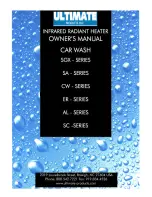
6
facts to consider aBout the location
Carefully choose an indoor location for the new water heater,
because the placement is a very important consideration for the
safety of the occupants in the building and for the most economical
use of the appliance.
Whether replacing an old water heater or putting the water heater
in a new location, the following critical points must be observed:
1. Select a location as close as practical or centralized to the point
of use. The water heater should be located in an area not subject
to freezing temperatures.
2. Selected location must provide adequate clearances for removing
the front cover in order to service parts such as the thermostat,
element, temperature sensor, anode, and high limit reset. Adequate
clearance for servicing this appliance should be considered before
installation, such as operating the relief valve, etc.
3. The water heater should be located so it is not subject to physical
damage by moving vehicles or area flooding.
4. The selected wall or cabinet must be capable of supporting at
least two times the weight of the water heater when filled with
water (77 lbs).
5. The water heater must be installed in a vertical position with water
inlet and outlet connections facing upwards and easily accessible.
Installation of the water heater must be accomplished in such
a manner that if the tank or any connections should leak, the
flow will not cause damage to the structure. For this reason, it
is not advisable to install the water heater in an attic or upper
floor. When such locations cannot be avoided, a suitable drain
pan should be installed under the water heater. Drain pans are
available from your local plumbing contractor. Such a drain
pan must have a minimum length and width of at least 2 inches
(51 mm) greater than the water heater dimensions and must
be piped to an adequate drain.
Water heater life depends upon water quality, water pressure,
water usage, water temperature, and the environment in which
the water heater is installed. Water heaters are sometimes
installed in locations where leakage may result in property
damage, even with the use of a drain pan piped to a drain.
However, unanticipated damage can be reduced or prevented
by a leak detector or water shut-off device used in conjunc
-
tion with a piped drain pan. These devices are available from
some plumbing supply wholesalers and retailers, and detect
and react to leakage in various ways:
• Sensors mounted in the drain pan that trigger an alarm or turn off
the incoming water to the water heater when leakage is detected.
• Sensors mounted in the drain pan that turn off the water supply to
the entire home when water is detected in the drain pan.
• Water supply shut-off devices that activate based on the
water pressure differential between the cold water and hot
water pipes connected to the water heater.
insulation BlanKets
Insulation blankets are available to the general public for external
use on electric water heaters but are not necessary with this product.
The purpose of an insulation blanket is to reduce the standby heat
loss encountered with storage tank heaters.
Should you choose to apply an insulation blanket to this heater,
you should follow these instructions below. Failure to follow these
instructions can result in fire, serious personal injury, or death.
•
Do not cover the temperature and pressure relief (T & P) valve
with an insulation blanket.
•
Do not cover the instruction manual. Keep it on the side of the
water heater or nearby for future reference.
•
Do obtain new warning and instruction labels for placement on
the blanket directly over the existing labels.
locatinG the new water heater
. READ ALL INSTRUCTIONS BEFORE USING THIS WATER HEATER.
important safetY instructions
2. This water heater must be grounded. Connect only to properly
grounded outlet. See GROUNDING INSTRUCTIONS found in the
WIRING section of this manual.
3. Install or locate this water heater only in accordance with the
provided installation instructions.
4. Use this water heater for its intended use as described in this
manual.
5. Do not use an extension cord set with this water heater. If no
receptacle is available adjacent to the water heater, contact a
qualified electrician to have one properly installed.
6. As with any appliance, close supervision is necessary when used
by children.
7. Do not operate this water heater if it has a damaged cord or plug, if
it is not working properly, or if it has been damaged or dropped.
8. T
his water heater should be serviced only by qualified service
personnel. Contact nearest authorized service facility for
examination, repair, or adjustment.
Summary of Contents for AOSRE50400
Page 3: ... GENERAL SAFETY ...
Page 10: ...10 WIRING DIAGRAM FIGURE 5 ...







































